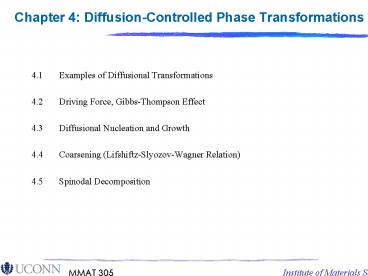Chapter 4: DiffusionControlled Phase Transformations PowerPoint PPT Presentation
Title: Chapter 4: DiffusionControlled Phase Transformations
1
Chapter 4 Diffusion-Controlled Phase
Transformations
- 4.1 Examples of Diffusional Transformations
- 4.2 Driving Force, Gibbs-Thompson Effect
- 4.3 Diffusional Nucleation and Growth
- 4.4 Coarsening (Lifshiftz-Slyozov-Wagner
Relation) - 4.5 Spinodal Decomposition
MMAT 305
2
4.1 Examples of Diffusional Transformations
MMAT 305
3
4.2 Driving Force, Gibbs-Thompson Effect
MMAT 305
4
4.2 Driving Force, Gibbs-Thompson Effect
MMAT 305
5
Precipitation
Microstructures at different stages during ageing
of Al-Cu alloys. (a) GP zones 720 000. (b) ??
63 000. (c) ?' 18 000. (d) ? 8000.
6
Precipitation
MMAT 305
7
Precipitation
MMAT 305
8
Precipitation
(a) The activation energy barrier to the
formation of each transition phase is very small
in comparison to the (b) barrier against direct
precipitation of the equilibrium phase (c)
Schematic diagram showing the total free energy
of the alloy v. time.
MMAT 305
9
Precipitation - Thermodynamics
MMAT 305
10
Precipitation - Thermodynamics
MMAT 305
11
4.4 Coarsening
The driving force for coarsening is the local
compositional gradient that is set up between
particles of equilibrium concentration of
different size. The reason for the local
compositional variation is the Gibbs-Thompson
effect.
MMAT 305
12
4.5 Spinodal Decomposition
MMAT 305
13
4.5 Spinodal Decomposition
MMAT 305
14
4.5 Spinodal Decomposition
MMAT 305
15
4.5 Spinoidal Decomposition
MMAT 305
16
4.5 Spinodal Decomposition
There is a potential difference due to the local
composition gradient
Compositional fluctuations
Strain energy due to compositional variation
MMAT 305
PowerShow.com is a leading presentation sharing website. It has millions of presentations already uploaded and available with 1,000s more being uploaded by its users every day. Whatever your area of interest, here you’ll be able to find and view presentations you’ll love and possibly download. And, best of all, it is completely free and easy to use.
You might even have a presentation you’d like to share with others. If so, just upload it to PowerShow.com. We’ll convert it to an HTML5 slideshow that includes all the media types you’ve already added: audio, video, music, pictures, animations and transition effects. Then you can share it with your target audience as well as PowerShow.com’s millions of monthly visitors. And, again, it’s all free.
About the Developers
PowerShow.com is brought to you by CrystalGraphics, the award-winning developer and market-leading publisher of rich-media enhancement products for presentations. Our product offerings include millions of PowerPoint templates, diagrams, animated 3D characters and more.

